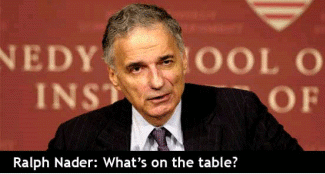Minor Parties in the 2000 Presidential Electionby BARRY C. BURDEN
NOTICE: THIS WORK MAY BE PROTECTED BY COPYRIGHTYOU ARE REQUIRED TO READ
THE COPYRIGHT NOTICE AT THIS LINK BEFORE YOU READ THE FOLLOWING WORK, THAT IS AVAILABLE SOLELY FOR PRIVATE STUDY, SCHOLARSHIP OR RESEARCH PURSUANT TO 17 U.S.C. SECTION 107 AND 108. IN THE EVENT THAT THE LIBRARY DETERMINES THAT UNLAWFUL COPYING OF THIS WORK HAS OCCURRED, THE LIBRARY HAS THE RIGHT TO BLOCK THE I.P. ADDRESS AT WHICH THE UNLAWFUL COPYING APPEARED TO HAVE OCCURRED. THANK YOU FOR RESPECTING THE RIGHTS OF COPYRIGHT OWNERS.
Though neither Patrick Buchanan nor Ralph Nader garnered as many votes as some earlier minor-party candidates, they had the potential to affect the 2000 presidential election in ways that their predecessors could not. This is possible because of the sheer closeness of the major-party vote. The popular vote nearly rendered the presidential contest a tie with Democrat Al Gore and Republican George W. Bush both winning about 48 percent of the vote. Moreover, the electoral college outcome, which depended on a contentious series of legal battles in Florida, gave Bush the majority by just one vote. Al Gore's 266 electoral votes are the most ever won by a losing candidate. [1] And 2000 was the first time in more than a century in which the winners of the popular and electoral votes were different. In an electoral context as balanced as this one, candidates from outside the two-party system who manage even meager showings can have remarkable effects on the election's outcome.
In this chapter I examine the roles that Reform Party nominee Buchanan and Green Party nominee Nader played in the 2000 presidential election. Using a variety of data from election returns, exit polls, and academic national surveys, I address two questions. First, how did minor-party voters reach their decisions given the great potential for sophisticated behavior in a close election? This requires that we determine the sources of minor-party support and the relationships between their electoral coalitions. Second, what effects did minor parties have on voter turnout and on who won the election? Answering this question requires us to analyze counterfactuals that estimate what would have happened had Buchanan and Nader not been running. The results expand the growing body of theoretical and empirical research on "major" minor parties in America generally as well as help us understand these parties' roles in the 2000 presidential election specifically. [2] The stark realities of this election are sure to force political scientists to rethink some of our conclusions about the dynamics of minor parties.
Minor parties have been of growing interest because their influence appears to have been increasing in recent years. In fact, five of the last nine presidential elections have seen strong minor-party showings. The most dramatic of these was Ross Perot's garnering of 19 percent of the popular vote in 1992 (Jelen 2001). There has also been substantial activity at the sub-presidential level, most notably Jesse Ventura's Reform Party victory in the 1998 Minnesota gubernatorial election (Lacy and Monson 2002; Lentz 2001). But if the appearance of new academic work on the subject is an indicator, there appear to be broader forces at work that are conspiring to overcome the standard hurdles facing minor parties at all levels of government (Bibby and Maisel 2002; Herrnson and Green 2002; Sifry 2002). One purpose of this chapter is to explore the role of minor parties in the 2000 presidential election in the light of a burgeoning body of research.
My analysis begins by reexamining the election outcome in terms of social-choice analysis.
A simple look at the preference rankings of candidates shows that, for the first time in the survey era, the winner of the presidential election was not the Condorcet winner, as explained in the next section. Moreover, almost no common voting method would have selected Bush as the winner. The analysis also shows than an unprecedented number of party supporters were strategic in 2000. The second section of this chapter analyzes Nader's standing in the polls dynamically by examining the patterns and determinants of his support over the final months of the campaign.
Unlike nearly all minor-party candidates, Nader actually rose in the polls over time, even after controlling for the closeness of the major-party vote and support for other candidates. The third section turns to the effects that Buchanan and Nader had on voter participation and the major parties' vote shares.
A larger number of minor-party voters would have abstained had their candidates not been in the race. Minor parties, most notably the Greens, increased turnout both directly by mobilizing votes for themselves and indirectly by adding interest to the campaign, for a total effect of around 2.5 percentage points. The next section of the chapter reexamines the possibility that Nader threw the election to Bush.
It is clear that Florida almost certainly would have gone Democratic without Nader in the race. Yet it is at least possible that Bush would have won easily in the electoral college without Buchanan in the race. I then turn to examining the sources of minor- party support.
Nader voters were more liberal, pro-choice, and educated than other voters on average. The factors that distinguished Nader from Gore in particular were primarily economic in nature. Nader voters disliked the administration's record and took their discontent out on Gore. Aggregate analysis shows that Nader did much better at drawing on his earlier support and Perot's base from 1996. Surprisingly, Buchanan and Nader both performed better where the major-party vote was closer. I conclude by suggesting how this multifaceted picture of results fits with existing work on minor parties in America.
A. Perverse Social-Choice FunctionElections are a key mechanism for aggregating individual citizen preferences into collective decisions. The proper way to do this is a matter of great contention. A prominent line of research focuses on the rationality of voting rules and a society's social-choice function. Though no single method of aggregation is ideal, some appear more perverse than others because they violate common assumptions about how preferences ought to be represented. Arrow (1951) has argued that seemingly trivial characteristics such as transitivity and nondictatorship should be maintained, but he has also shown that no voting system can maintain several such characteristics simultaneously. This "impossibility result" confirms that no vote aggregation method is perfect. Plenty of examples can be generated that produce rather different social outcomes from the same individual preferences simply by altering the aggregation rules. At a minimum, one would hope that some basic principles of fairness are retained that at least make the process, and thus the outcome, appear legitimate to voters (see Hibbing and Theiss-Morse 1995).
Two common voting methods are majority and plurality rule. Majority rule would have failed in 2000 because no candidate won 50 percent of the popular vote. Plurality rule would have elected Gore since he won the popular vote. Neither majority nor plurality rule is more natural than or superior to more complicated methods.
Indeed, the Founders purposely created the electoral college to avoid popular election. The question becomes whether this rather unique method of election selected the same winner that other aggregation schemes might have, or whether Bush's victory was an idiosyncratic result of the particular set of institutions and events that put him into office. [3]
One of the most stringent methods of selecting a candidate was proposed by the Marquis de Condorcet more than two hundred years ago. Condorcet argued that a winning alternative ought to be capable of defeating all other alternatives in head-to-head comparisons. That is, A should be the victor only if she beats both B and C in paired situations. Even if some voters choose strategically rather than sincerely -- perhaps due to a combination of mechanical and psychological incentives (Duverger 1963) -- the Condorcet winner should also be the election winner. The Condorcet criterion is an especially desirable method of choosing among multiple candidates because it sets the threshold of victory quite high. In many elections, a Condorcet winner does not even exist.
National Election Study (NES) data from 2000 make it possible to conduct a crude analysis of strategic voting. I follow a long line of research that uses rankings of the candidates on the NES "feeling thermometers" as estimates of the relative ordinal utilities each person has for each candidate. Thermometers are reasonable proxies for respondents' utilities for the candidates and tend to predict voting decisions well (Abramson et al. 1992, 1995, 2000; Brams and Fishburn 1983; Brams and Merrill 1994; Kiewiet 1979; Ordeshook and Zeng 1997; Palfrey and Poole 1987; Weisberg and Grofman 1981; Weisberg and Rusk 1970). Abramson and colleagues (1995) show that the winners of the popular and electoral vote in three notable third-party elections -- 1968, 1980, and 1992 -- were all Condorcet winners. In each of those years the electoral college victor also would have won the popular vote using Condorcet's standard of beating each of the other candidates in head-to-head comparisons. Clinton was easily the Condorcet winner in 1996 as well (Abramson, Aldrich, and Rohde 1998).
It is reassuring that different voting schemes -- simple plurality rule, the electoral college, the Condorcet criterion, and perhaps even approval voting -- all select the same candidate in each of the past four elections with significant minor parties (Brams and Fishburn 1983; Brams and Merril11994; Kiewiet 1979). It is more remarkable that every presidential election for which adequate survey data exist seems to have chosen the Condorcet winner, regardless of minor-party showings. This is satisfying because no voting method is ideal, and the Condorcet method is so stringent.
The 2000 election is not so tidy. Not only did George W. Bush not take the popular vote, but the data clearly show that he was not the Condorcet winner either. This is apparently the first time in the survey era that this has happened. Figure 11.1 shows the pairwise rankings of the four presidential candidates in graphical form. [4] The arrows point to the candidates who lose in each comparison. Pat Buchanan is the "Condorcet loser" because each of the other three candidates beat him in head-to-head comparisons. This is indicated by the three arrows pointing toward his name. Gore is the Condorcet winner, beating each of the other candidates (see also Abramson, Aldrich, and Rohde 2002). In between these two extremes, Nader is preferred to Buchanan but loses to both major-party nominees. Bush loses to Gore but defeats both minor-party candidates.
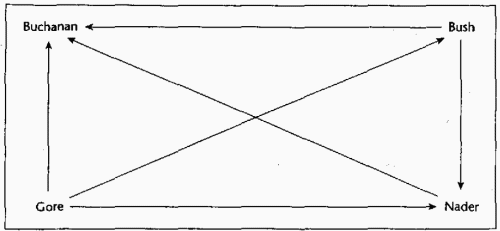
Several other voting methods would also choose Gore as the winner. Running through the list of voting methods that are commonly discussed in textbooks on the subject (e.g., Shepsle and Bonchek 1997), Gore wins whether one uses a plurality runoff, a sequential runoff, or approval voting procedures. [5]
The 2000 election thus represents a highly unusual event in modern U.S. politics, as the electoral college appears to be the only existing nondictatorial method that would result in George W. Bush's election.The thermometer rankings also show an unprecedented degree of strategic voting. Other presidential elections where strong minor parties ran of course saw strategic voting, but
the pivotal roles that Buchanan and Nader played in 2000 took strategic behavior to a new plateau. Table 11.1 demonstrates this by comparing respondents' candidate rankings along with their vote choice and turnout decisions.
The data show that a large majority of those who rated Buchanan or Nader as their most preferred candidates before the election actually voted for someone else. Among voters, over 80 percent of people who rated Buchanan or Nader highest did not vote for them. Most of the Nader preferrers who voted chose Gore, with the remainder splitting between Bush and Nader.This suggests that many voters were deciding which candidate from outside the current administration was worth their support rather than simply whose platform was nearest their ideal points (Cho 2000; Lacy and Burden 2002). It seems that Nader preferrers and Nader voters are two distinct groups. If the Nader camp was comprised mostly of traditional liberals interested in ideological purity, a strategic voter would have chosen Gore. Presumably, a leftist voter who prefers Nader but fears that his candidacy is not viable would turn to Gore as second choice. A sizable contingent of Nader preferrers appear to have felt that way but abstained. Although many Nader preferrers who voted did pick Gore, it remains counterintuitive that so many voted for Bush instead. Many of these voters must have been motivated not just by progressive ideals but by the desire to end the Clinton-Gore reign and decided that Republican Bush was most likely to do that.
Respondents who ranked Buchanan first were even more disloyal, but their strategic votes were cast more in Bush's direction than in Gore's. More interesting are the abstention rates for each of these groups. About one in five Bush preferrers abstained while one in four Gore supporters did. But more than a third of those who favored Nader abstained, and 42 percent of Buchanan's preferrers stayed home.
This is an unprecedented amount of strategic voting among minor-party supporters (see Abramson et al. 1995; Cho 2000; Ordeshook and Zeng 1997). Strategic considerations are even more widespread if strategic "voting" means more than just choosing a candidate who is not one's most preferred alternative. To the extent that abstention is a purposeful activity akin to choosing a candidate (Aldrich 1997; Lacy and Burden 1999,2002), many Americans who preferred Buchanan or Nader found nonvoting a more satisfactory decision than either jumping to a minor-party candidate at the other end of the spectrum or stomaching one of the major-party standard-bearers.
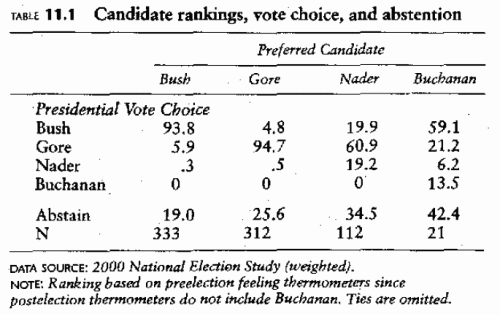
It is noteworthy that abstention rates were highest among voters who preferred one of the minor-party candidates. This lack of participation does not necessarily imply lack of enthusiasm for the candidate, however. The strength of support for a chosen presidential candidate was weakest for Nader. Nader voters said they felt less enthusiastic about their choice than did people who voted for one of the other three candidates. The percentage of NES respondents saying they "felt strongly" was 74 percent for Gore, 79 percent for Bush, and even 83 percent for Buchanan, but only 64 percent for Nader. The fact that so many of those who ranked Nader first abstained suggests that they were not particularly fond of any of the candidates. Those who voted for Nader probably felt tepid toward all of the candidates running and were only willing to cast protest votes because the antiestablishment Greens happened to be on the ballot. This might explain why apparently not many Nader voters regret their decisions. Only one in ten Nader voters say they wish they could change their vote after knowing how close the election was (Jackman 2000). Given the perversity of the election result shown earlier, it is simply remarkable that 90 percent would pick Nader again even knowing that Bush -- often their third- or fourth-ranked choice -- would be elected president.
Campaign DynamicsSome of the more interesting aspects of minor parties are the changes they induce in otherwise normal presidential campaigns (Rosenstone, Behr, and Lazarus 1996). Among other things, a threatening outsider causes the Democratic and Republican nominees to deal with new issues, distribute their resources differently, and assemble altered coalitions. Strong minor parties introduce a great deal of uncertainty into the campaign and force the major parties to begin foraging about for votes more strategically. As a zero-sum game, any support that goes to third-party candidates effectively reduces the pool of votes available to the major parties. At the same time, the possibility of increasing turnout makes the situation look more like a positive-sum game. However, new voters mobilized by a minor party are relatively unpredictable, which often leads the major parties to shore up their bases.
To examine some of these dynamics, I have gathered trial-heat and tracking polls conducted over the last two months of the campaign. Nader's support in the polls bucks historical trends in one important way: it rises rather than falls. As Rosenstone, Behr, and Lazarus (1996, 41) argue, "Third-party support fades as the election approaches. This pattern of declining support has been apparent since the advent of survey data." [6] Though Rosenstone, Behr, and Lazarus argue that voters are apparently willing to consider minor-party candidates when the stakes are low, the electorate abandons them when the stakes increase near Election Day. They show that this pattern holds for seven different candidacies ranging from Robert LaFollette in 1924 to John Anderson in 1980.Figure 11.2 shows that this decline does not hold for Nader. [7] Though the raw data points are a bit lumpy due to rounding, Nader's support clearly rises. A spline fit to the data shows the upturn well. Despite the variation around the main trend line, there seems to be about a percentage-point increase over the last two months of the presidential campaign.
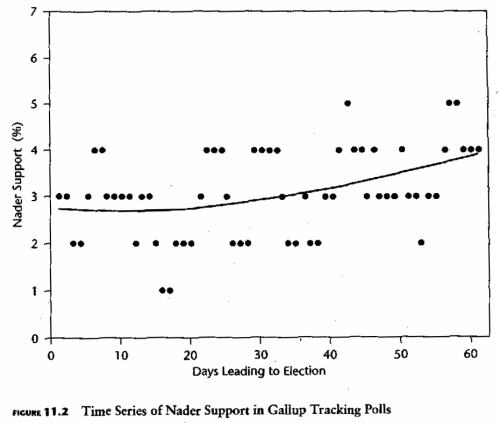 Nader's rise in the polls apparently defies history. Not only does minor-party support wane in most polls as the consequences of committing to a candidate rise, but the 2000 major-party race remained close enough that Nader votes could have swung the election. Because of the closeness, one might have expected Nader to fall even faster than minor parties running in more lopsided elections. A "gut check" by Nader supporters late in the campaign should have caused them to waiver and throw their support, however weak, to Gore as the second best. If sophisticated maneuvering does not explain the rise in Nader support, what does?
Nader's rise in the polls apparently defies history. Not only does minor-party support wane in most polls as the consequences of committing to a candidate rise, but the 2000 major-party race remained close enough that Nader votes could have swung the election. Because of the closeness, one might have expected Nader to fall even faster than minor parties running in more lopsided elections. A "gut check" by Nader supporters late in the campaign should have caused them to waiver and throw their support, however weak, to Gore as the second best. If sophisticated maneuvering does not explain the rise in Nader support, what does?Table 11.2 reports several simple time-series regression models of Nader support. [8] There are five columns, each of which introduces different independent variables to the analysis. The variables include a simple daily counter, Gore and Buchanan vote percentages, and a measure of the closeness of the race. Closeness is measured as the absolute difference between the Bush and Gore percentages, so higher values indicate a more lopsided race. This is done to be sure that the relationship between time and Nader's support is not spurious. It might be, for example, that Nader's support rises only because the race gets closer.
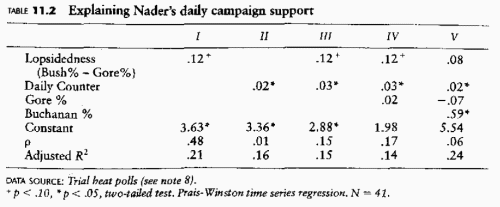
The first three columns of Table 11.2 examine the relationships between time, closeness, and Nader support. It appears -- both independently and jointly -- that Nader's standings rise later in the campaign and when the race is more lopsided. So Nader does better later in the campaign, even after showing that many of his supporters strategically left him when the major party campaign got tighter. The last two columns reveal how his support interacted with the nearest substitutes, Buchanan and Gore. It is perhaps surprising that Buchanan and Nader appear to do well or poorly together, as indicated by the positive and significant coefficient on the Buchanan variable. In the end, however, this analysis confirms that Nader's unique rise in the polls over the final weeks of the campaign is not due merely to closeness or the standings of the other,candidates. The daily counter remains significant regardless of the control variables introduced. In addition, the size of the coefficient confirms the finding in Figure 11.2 that Nader rose about a point over the last two months of the campaign.
Turnout and Vote-Stealing EffectsTwo of the most important effects a minor-party candidate can have are in increasing voter turnout and in altering the major-party vote split (Lacy and Burden 1999, 2002). Minor parties, of course, shake things up in a host of other interesting ways, from altering the campaign agenda to fracturing the major- party coalitions. In the end, however, it is enlightening to know how the election results would have been different without minor parties in the mix. Though one can never answer these counterfactual puzzles definitively by rerunning history (Asher 1995), they are ways of gaining insight on such questions using available data. We must make do by asking how things would have been different with Buchanan or Nader out of the race, assuming that everything else about the campaigns would have remained the same. This is an unrealistic but unavoidable assumption.
Exit polls asked voters about their choices in the hypothetical situation in which neither Buchanan nor Nader was running. [9] Table 11.3 presents a cross-tabulation of these hypothetical questions and self- reported votes. Because minor parties earned so few votes, the aggregate major-party split remains right at fifty-fifty even removing Buchanan, Nader, and the other minor-party nominees.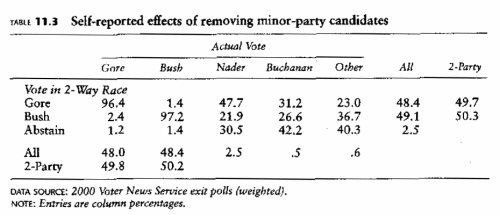
More intriguing is what individual voters would have done. Nearly all Bush and Gore voters would have remained loyal in a two-way race, as one might expect. This fits with the great consistency between ranking of and voting for major parties shown earlier. In contrast, many minor-party voters would have abstained. Nearly 30 percent of Nader voters and more than 40 percent of Buchanan voters would have abstained without their candidates in the race. About half of Nader's votes would have gone to Gore, the perceived next-best candidate. It might seem surprising that Buchanan's brigade would have switched to Gore at least as strongly as it lined up behind Bush, though I will provide some evidence later that Buchanan drew heavily on the normally Democratic union vote. Regardless, this result should be taken lightly since the number of Buchanan voters is too low (33) to reach firm inferences. The point is merely that Buchanan's bloc would not have all gone to Bush nor would all Nader votes have necessarily gone to Gore.
One can estimate the effects the candidates had on voter turnout by multiplying their actual vote shares by the percentage who would have abstained in a two-way race. For example, 30.5 percent of Nader's 2.5 percent of the popular vote -- or 0.75 percent -- would have stayed home if he had not run. Taken together, minor parties boosted turnout directly by roughly 1.2 percentage points in 2000.
But candidates also have indirect effects on voter mobilization. Whereas direct effects are caused by a candidate mobilizing his supporters in an immediate way, indirect effects occur when supporters of one's opponents are mobilized by systemic changes in the campaign. Indirect effects are caused by such things as increasing closeness, adding color and drama to the race, introducing issues that mobilize new voters, and simply raising voter interest. The percentage of Bush and Gore voters who would have abstained in a two-way race is suggestive of how large these indirect effects might have been. These voters presumably turned out for one of the major-party candidates because a minor-party candidate reminded them about the importance of voting or threatened their candidates' victory. Without Buchanan or Nader in the race to make things interesting, they would have abstained. The percentages of Bush and Gore voters who would have behaved this way are small since most would have voted in a two-way race as well, but they are many in number. Using the same method I used earlier, I estimate that turnout for Bush and Gore would have fallen by a similar 1.3 points, for a total (direct and indirect) turnout effect of about 2.5 points. [10]These self-reported results are reasonable, but ought to be taken with a grain of salt given the small samples and known differences between opinions and behavior. If the results are reliable, they ought to be replicated in other data. To check this, I turn to aggregate election returns to help develop an understanding of the turnout consequences of minor-party voting in 2000. Because the electoral college operates on a winner-take-all basis within states, the first analysis relies on states as the units of analysis.
The results are found in Table 11.4. The regression models suggest that state electorates with more whites, fewer cities, more education, and higher incomes all have higher turnout. These variables capture interstate differences sufficiently well that southern exceptionalism has disappeared. As expected, the closeness of the race seems to have a positive effect on turnout after controlling for minor-party showings. This could be because closeness per se encourages potential abstainers to turn out or because a closer race causes the candidates to engage in more voter mobilization (Cox and Munger 1989). Buchanan has a negligible effect on turnout, but Nader in contrast appears to have increased voter participation directly.
This state-level analysis, in conjunction with the survey data analyzed earlier, confirms that Nader had an indisputable effect on voter turnout. Many of his supporters were so committed to him -- or dissatisfied enough with every other candidate -- that they simply would have abstained had Nader not run. It is this inverse relationship between voters' enthusiasm and their candidate's vote shares that allows some of the poorest-performing minor parties to have some of the largest direct effects on voter turnout.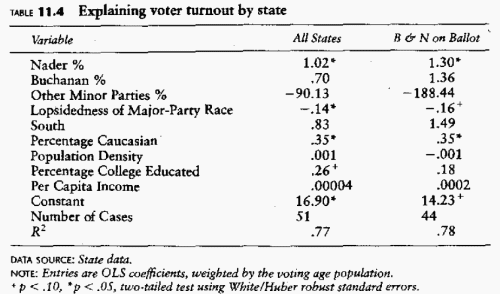
Though many would have chosen not to vote in a two-way race, the largest group of Nader voters would have gone to Gore. In fact, many journalists have speculated that the Florida fiasco could have been avoided if Nader had not run since Gore would have picked up enough net Nader supporters to defeat Bush there.
Throwing the Electoral CollegeThe analysis presented so far indicates that the outcome of the 2000 election was perverse. Bush not only lost the popular vote but also failed to be the Condorcet winner. Nonetheless, these findings do not address whether Nader indirectly elected Bush by stealing votes disproportionately from Gore. Though many Nader voters said they would have voted for Gore in a hypothetical two-way race, it is difficult to know how well these responses would predict their actual behavior were that to occur. And the data presented so far are merely national averages that cannot reveal how minor parties affected the major- party vote in particular states.
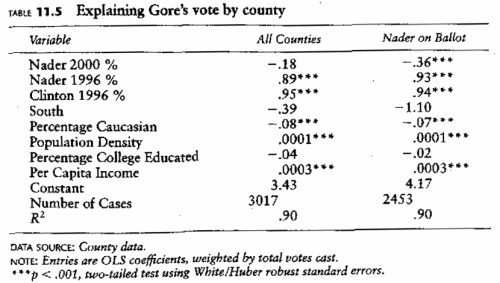
Florida was the center of attention for over a month following the November 7 election. The razor-thin result there was subject to ballot recounts and a series of legal maneuvers by the parties aimed at starting, stopping, and controlling the recounts. Just a few hundred votes separated Bush from Gore, yet Nader received nearly 100,000 votes. If even a small fraction of his voters had chosen Gore instead, the Democrats would have won the presidency. [11] In fact, Buchanan and six even more obscure minor- arty candidates each received more votes than Bush's margin of victory. Together, these extremely small minor parties account for 250 times the 537 votes that distinguished Bush from Gore in the end.
Though Nader's absence might have given Gore a clear Florida win, the absence of a number of right-wing minor-party candidates from Buchanan to Hagelin to Browne might have allowed for a clear Bush victory.Although issues of ballot design and election law are important, they have overshadowed the kingmaker effects that Nader and other minor-party nominees might have had beyond the butterfly ballot. [12] For a deeper look at this relationship, Table 11.5 shows the results of a regression model that explains the Gore vote. Here the dependent variable is Gore's vote share in each county, though the specification looks much like the state-turnout model in Table 11.4. Nader's support in 1996 and 2000 are included as independent variables to determine how the Gore and Nader fortunes co-varied. In addition to a set of control variables, Clinton's share of the 1996 vote is included to measure general support for Democratic presidential candidates and the Clinton-Gore administration.
The results suggest that Gore and Nader were indeed viewed as near, though certainly not perfect, substitutes, as indicated by the negative sign on the variable for Nader's vote share in 2000.
This suggests that although Nader drew some of his support from the Gore camp, a much larger share of it came from other sources. Potential abstainers appear to make up the lion's share of Nader's support. This corroborates the substantial turnout effects found in the state analysis (Table 11.4) and the self-reported estimates in which many Nader voters report that they would have abstained in a two-way election.

However, many Nader voters also stated that they would have supported Gore had their candidate not been running. If the dynamics in Florida were at all similar to this average effect, then it is evident that Al Gore would be president today had it been a traditional two-candidate race. But was Ralph Nader able to drain away enough Democratic votes to cost Gore the presidency?
In the days following the-election itself, the unsettled Florida outcome left the electoral college up for grabs. Gore held 266 electoral votes to Bush's 246. Since 270 are needed to win the presidency outright, the Florida outcome would determine the next president of the United States, as long as the other state outcomes remained fixed. At the same time, four other states were won by razor-thin margins that could have gone either way. Even conceding Florida to Gore, Bush could have won the presidency with moderate vote shifts in Iowa, New Mexico, Oregon, and Wisconsin. Collectively, they could have thrown the election to Bush.
As Table 11.6 shows, Gore beat Bush by a small number of votes in each of these four states. In all four states the Bush-Gore margin accounted for less than half a percent of the total votes cast (the same threshold below which Florida law requires a recount). Yet together these four states hold thirty electoral votes, five more than in Florida. [13]
Also, in each of these states Buchanan won more votes than the difference between Bush and Gore.
Had Buchanan not been on the ballot it is at least possible that Gore would have lost these states and Bush would have been elected regardless of the Florida outcome. It is difficult, however, to know for certain. All that would have been required was that enough Buchanan voters chose Bush rather than vote for Gore or abstain. Assuming for the moment that no Buchanan voters would have chosen Gore, "enough" is anywhere from a reasonable 13 percent in New Mexico to a less realistic 65 percent in Iowa. Since many Buchanan voters nationally would have picked Gore in a two-way race, the thresholds were higher than this in reality.
One cannot know for certain whether Bush would have won these four states without Buchanan in the race. It appears to be possible but perhaps not likely. National exit polls indicate that about one in four Buchanan voters would have chosen Bush, but the ratios probably vary depending on the state. Unfortunately, state exit polls included too few Buchanan voters to reach firm conclusions. Had Pat Buchanan not been running, it is at least plausible, though perhaps not likely, that Florida would have been subject to less scrutiny and that Bush would have been elected easily with as many as 301 electoral votes.
Sources of Minor-Party SupportAccording to exit polls, Nader's support came mostly from those who voted for Clinton in 1996 and, secondarily, from those who abstained in that election. Together, they made up 55 percent of the Nader coalition. This confirms the suspicion that he drew mostly from the left and from those less engaged with the system. As a share of previous voters, Nader drew mostly from the Perot camp, though it is only about a tenth of "Perotistas," and this smaller pool makes the total Perot contribution modest. More Perot voters broke for Bush in 2000 than for all of the others candidates combined (Rapoport and Stone 2001).
It is not yet clear what individual-level determinants drove citizens to vote for Buchanan and Nader. To address this question I estimate a vote-choice model using exit-poll data. These data have the benefit of large samples that make it possible [to] analyze minor-party voting. Otherwise rich NES data simply have too few Buchanan and Nader voters to allow firm inferences. The primary drawback of exit polls is that the sample excludes abstainers, but this is an unavoidable trade-off.
I estimate a discrete-choice model that includes a set of explanatory variables generally suspected to influence vote choice. These variables fall into four broad categories. I begin with measures of general political orientation: party identification and ideology. Both are long-term attachments shown to have strong effects on voting behavior. Next are several economic evaluations. Economics and elections are deeply intertwined, and these variables allow for national and personal as well as retrospective and prospective judgments to influence vote choice. The third set of variables measures the sociocultural nature of contemporary American elections. I include a variable that measures attitudes on abortion, a measure of religious attendance, and a variable that weighs whether a person identifies with the religious right. Finally, I include a set of demographic control variables such as race, education, gender, and age. The wordings of the questions are given in the Measurement Appendix at the end of this chapter.
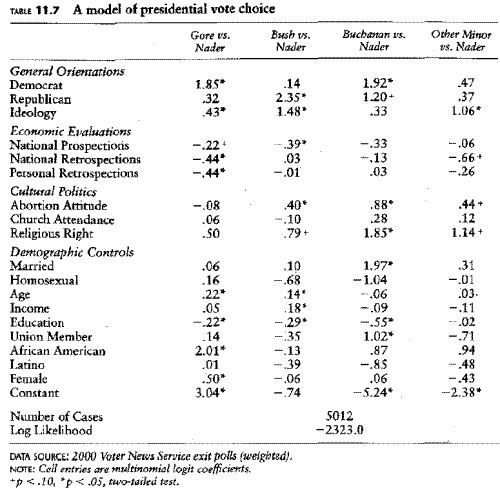
The estimates in Table 11.7 show how variables influenced the choices between each of the other candidates and Nader. Nader is chosen as the arbitrary baseline category since not all pairwise comparisons are simultaneously estimable. Using Nader as baseline allows one to examine the most interesting Gore-Nader and Buchanan-Nader comparisons. Positive coefficients indicate that higher values on the independent variables lead to a greater likelihood that voters support a candidate other than Nader.
For example, the significant coefficient of .50 on the female dummy variable reveals that women are significantly more likely to vote for Gore than Nader, all else held constant. But the variable's insignificance in the remaining columns indicates that women are no more likely to vote for another candidate relative to Nader. Some classes of variables affect all of the comparisons with Nader while others influence only one or two of the pairings.
The major factors separating Gore and Nader voters are economic evaluations. Economic variables fail to achieve statistical significance in most other cases, but all three measures are strongly related to the Gore-Nader vote.
In all three cases those who are less content with the economy tend to choose Nader over Gore. This might reflect a failed strategy on Gore's part in not associating himself closely enough with strong economic performance during the Clinton years. This was difficult to do, of course, since Gore also wished to distance himself from Clinton the person. It might also be that Nader voters misperceived the strong economy as weak or that they focused on different aspects of economic performance such as inequality. Although most Americans viewed the economy positively in 2000 (see Norpoth, Chapter 3 in this book), those who were dissatisfied with it clearly turned to Nader over Gore.
In accord with earlier work (Cho 2000; Lacy and Burden 1999, 2002), it seems that minor-party candidates owe much of their support to anti-incumbent sentiment. And the substantive effects of these variables are not trivial. For a voter who is undecided between Gore and Nader, viewing the current economy as "poor" rather than "excellent" increases his probability of picking Nader from .50 to .79, a change of nearly thirty percentage points. Though national retrospections turn out to matter more than national prospections and personal retrospections, all three clearly separated Gore and Nader voters in 2000.
Contrast the power that economics has to separate Gore and Nader voters with the weaker effects of the cultural variables. Attitude toward abortion and identification with the religious right have consistent effects on every comparison aside from Gore-Nader. Pro-choice voters are more likely to choose Nader than Bush, Buchanan, and other minor parties. Yet abortion attitudes do not distinguish between Gore and Nader. Again, assuming that a voter is initially torn between the candidates, the probability of voting for Nader rises by anywhere from .27 (Bush) to. 43 (Buchanan) as we move from the pro-life voter to the pro-choice voter. For at least some voters abortion was definitive. The power of these variables to shape the voting decision fits with earlier work on the importance of abortion in modern electoral politics (Abramowitz 1995; Adams 1997). But other cultural issues matter too.
Belonging to the religious right makes a person 19 to 36 percent more likely to vote against Nader. These effects are strongest for the Buchanan-Nader pairing, which makes sense given the socially conservative content of the Buchanan rhetoric. Consistent with this, married respondents are far more likely to pick Buchanan over Nader, though marriage has no impact otherwise. In contrast to the denominational differences that drive voting based on sociocultural issues, religiosity itself, at least as measured by frequency of church attendance, appears unrelated to vote choice in 2000 (cf., Gilbert et al. 1999).
Long-term political orientations such as partisanship, ideology, and demographic predispositions have strong effects on vote choice.
As one might expect, liberals are almost always more likely to vote for Nader than an opponent, and partisans support their nominees in most cases. The one exception to this is that both Democrats and Republicans favor Buchanan over Nader. This might reflect the fact that Nader, unlike former Republican Buchanan, comes from outside of the conventional party system. This finding reinforces two themes. First, of all voters, Nader voters were the least enamored of the entire slate of candidates. Second, minor-party candidates differ from one another about as much as they differ from their major-party competitors.
Finally, though African Americans and to a lesser degree women favored Gore over Nader, age and education had more systematic effects on the Nader vote.
All else remaining constant, younger voters and those with more education were more likely to vote for Nader. This fits with conventional views of party identification and minor-party voting in which the young are expected to support minor parties disproportionately. It is noteworthy that age does not distinguish Buchanan and Nader voters, as young people tend to support minor parties of all stripes. Though income and education are often assumed to run in the same direction because they contribute to a person's socioeconomic status, they sometimes work in opposite directions here.
Nader occupied a niche that attracted those with higher educations and lower incomes. Although both Buchanan and Nader raised objections to free trade, union members were more likely to favor the Reform Party than the Green Party in 2000. Whereas Nader seems to have won votes on college campuses, Buchanan collected more in the union halls.
Many Americans knew they might be electing their third-most preferred candidate, so why did so many nonetheless vote for Buchanan and Nader?
The vote-choice model revealed that Nader tended to win the votes of white, liberal yet nonpartisan voters who were discontented with the economy. These findings confirm earlier work that found that economic grievances, age, and strength of partisanship are all associated with minor-party support (Abramson et al. 1995, 2000; Alvarez and Nagler 1995, 1998; Gold 1995; Lacy and Burden 1999, 2002; Rosenstone, Behr, and Lazarus 1996). But in addition to understanding why individuals behave as they do, we should also wonder what contributes to minor- party showings at the aggregate level.
Table 11.8 addresses this issue by regressing the Buchanan and Nader county vote shares on a series of political and demographic variables. In addition to a common set of controls, I include measures of Nader's showing in 1996 to measure support specific to his candidacy. But I also wish to see the degree to which Buchanan and Nader drew from Perot's 1996 base and the votes of other minor parties that year. Rapoport and Stone (2001), for example, find that Republicans, not minor parties, were the main beneficiaries of the Perot movement's collapse. It is reasonable to hypothesize that minor parties drew support from the Perotistas as well. Finally, the closeness of the election is included to assess strategic voting.
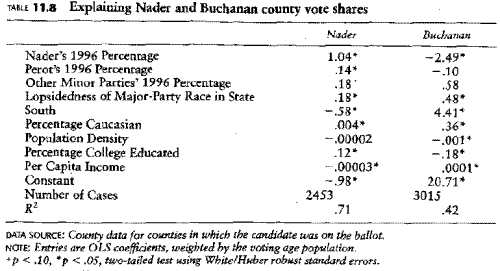 The results indicate that Nader far exceeded Buchanan's ability to build on his earlier campaigns. Not only did Nader regain most of the votes earned in his lackluster 1996 run for president, but it appears that he drew from the Perot camp as well. Nader took about 15 percent of the 1996 Perot vote while Buchanan apparently pulled in none.
The results indicate that Nader far exceeded Buchanan's ability to build on his earlier campaigns. Not only did Nader regain most of the votes earned in his lackluster 1996 run for president, but it appears that he drew from the Perot camp as well. Nader took about 15 percent of the 1996 Perot vote while Buchanan apparently pulled in none.Once again, the analysis shows that differences among minor parties make it difficult to generalize. Much of the literature looks for commonalties in voting for different minor parties across elections (Gold 1995; Gilbert et al. 1999; Herrnson and Green 2002; Lacy and Burden 2002; Rosenstone, Behr, and Lazarus 1996). However, researchers ought to acknowledge differences as well.
Nader was more likely to win the votes of those living outside the South, with more education, and with lower incomes. Buchanan did better in the South and among those with less education and those with higher incomes. Buchanan and Nader appealed to quite different kinds of voters.After including the 1996 minor-party vote shares and controlling for demographics like race, region, and education, the lopsidedness of the election is positively related to both the Buchanan and Nader votes. This confirms a finding repeated throughout this chapter: that minor-party voters were highly sensitive to the possibility of being pivotal in a close major-party contest. The "wasted vote" logic and sophisticated voting were apparently on many Buchanan and Nader supporters' minds.
ConclusionThe 2000 presidential election has done much to enlighten our understanding of minor parties in U.S. politics. At a practical level, 2000 added two fascinating observations to the growing number of cases available for study. In some ways, this research will reinforce earlier conclusions based primarily on Wallace, Anderson, and Perot. For instance, supporters of minor-party candidates are less partisan and less satisfied with the nation's economic performance than other voters. These are the same relationships that helped and hurt earlier minor parties.
At the same time, the Buchanan and Nader candidacies stand apart from their predecessors.
Among other things, these candidates could have easily affected who won the election. Gore probably would have won without Nader in the picture, and Bush could have won more easily had Buchanan not been around. These minor-party candidates occupy an important slot at the end of a string of such candidacies. Indeed, five of the last nine presidential elections have witnessed significant minor parties.
Nader rather than Buchanan managed to build on these successes by tapping into the bank of Perot's voters. Nader's candidacy is unique in that his standing rose during the final days of the campaign, an anomaly among minor-party presidential campaigns. And despite the closeness of the election, minor-party voters in 2000 were far more strategic than their predecessors.
A larger share of Buchanan and Nader supporters would have rather abstained than vote for another candidate. These unusual dynamics led to one of the least satisfying social-choice outcomes of any presidential election.One of the findings of this chapter is that Buchanan and Nader introduced an unprecedented amount of distortion into the aggregation of preferences. This was possible because of the extreme closeness of the major-party contest. Though eventually chosen the victor, Bush did not win the popular vote and would not have won using just about any other democratic voting method. Nader also made minor-party history by defying the strong tendency of such candidates to lose support in the final days of the campaign. It actually appears that Nader rose in the polls in the weeks preceding election day, this despite the possibility that his presence meant the election could be thrown to many of his supporters' third-choice candidate. Building on earlier work, this chapter also showed that minor-party candidates have effects on both turnout and the major-party vote shares. Buchanan and Nader had surprisingly large turnout effects despite their small vote totals. This suggests that the most meager campaigns might actually raise turnout the most because they bring out diehard supporters who would otherwise abstain. Running as minor-party candidates in the same election, Buchanan and Nader remind us of the great, though often downplayed differences among such candidates.
Nader drew support from young voters, the educated, liberals, and those upset with the economy; Buchanan won his votes in the South, from the religious right, and from the less educated. These differences warn against the development of a grand theory of minor-party coalitions.MEASUREMENT APPENDIXExit-poll data were collected on Election Day 2000 by the Voter News Service. Pollsters collected self- administered questionnaires from more than thirteen thousand voters. In Table 11.3, the two-way race question is "If these were the only two presidential candidates on the ballot today, who would you have voted for? 1 Al Gore (Dem), 2 George W. Bush (Rep), 3 Would not have voted for president." The wording of the questions used in Table 11.7 are listed here. Note that several of them were recoded in the ways explained earlier in this chapter.
Democrat and Republican: "No matter how you voted today, do you usually think of yourself as a: 1 Democrat, 2 Republican, 3 independent, 4 Something else?"
Ideology: "On most political matters, do you consider yourself: 1 Liberal, 2 Moderate, 3 Conservative?"
National Prospections: "During the next year, do you think the nation's economy will: 1 Get better, 2 Get worse, 3 Stay about the same?"
National Retrospections: "Do you think the condition of the nation's economy is: 1 Excellent, 2 Good, 3 Not so good, 4 Poor?"
Personal Retrospections: "Compared to four years ago, is your family's financial situation: 1 Better today, 2 Worse today, 3 About the same?"
Abortion Attitude: "Which comes closest to your position? Abortion should be: 1 Legal in all cases, 2 Legal in most cases, 3 Illegal in most cases, 4 Illegal in all cases. "
Church Attendance: "How often do you attend religious services? 1 More than once a week, 2 Once a week, 3 A few times a month, 4 A few times a year, 5 Never."
Religious Right: "Do you consider yourself part of the conservative Christian political movement, also known as the religious right? 1 Yes, 2 No."
Married: "Are you currently married? 1 Yes, 2 No."
Homosexual: "Are you gay, lesbian, or bisexual? 1 Yes, 2 No."
Age: "To which age group do you belong? 1 18-24, 2 25-29, 3 30-39, 4 40-44, 5 45-49, 6 50-59, 7 60- 64, 8 65-74, 9 75 or over."
Income: "1999 total family income: 1 Under $15,000, 2 $15,000-$29,999, 3 $30,000-49,999, 4 $50,000-$74,999, 5 $ 75,000-$99,999, 6 $100,000 or more?"
Education: "What was the last grade of school you completed? 1 Did not complete high school, 2 High school graduate, 3 Some college or associate degree, 4 College graduate, 5 Postgraduate study."
Union Member: "Do you or does someone in your household belong to a labor union? 1 Yes, I do, 2 Yes, someone else does, 3 Yes, I do and someone else does, 4 No one does."
African American and Latino: "Are you: 1 White, 2 African American, 3 Hispanic/Latino, 4 Asian, 5 Other?"
Female: "Are you: 1 Male, 2 Female?"













